This article needs additional citations for verification .(April 2021) |
Heritage Shunters Trust (HST) is a trading name of The South Yorkshire Railway Co. Ltd. which was founded in 1989. [1]
This article needs additional citations for verification .(April 2021) |
Heritage Shunters Trust (HST) is a trading name of The South Yorkshire Railway Co. Ltd. which was founded in 1989. [1]
HST is a railway preservation society and is the only preservation society that specialises in the preservation of ex-British Railway diesel shunters in the United Kingdom, although they do have a Class 14 which is a Type 1 locomotive and not a shunter.
Most of the locomotives are kept at Rowsley, Derbyshire, England, on the site of preserved railway Peak Rail but the company is a separate outfit. Galas are usually held twice a year where the collection is put on display and brake van rides are hauled by an assortment from the active fleet. Guided tours of the collection, and the viewing of restoration work being undertaken, are available most weekends for a small charge.[ citation needed ]
The Heritage Shunters Trust (HST) was established in 1989 with the primary objective of preserving and restoring British Railway diesel shunters. These locomotives, once ubiquitous in rail yards and industrial sidings, were facing an uncertain future due to the decline of traditional shunting operations.
HST has the following locomotives.[ citation needed ]

A switcher locomotive, shunter locomotive, or shifter locomotive is a locomotive used for maneuvering railway vehicles over short distances. Switchers do not usually move trains over long distances, instead they typically assemble trains in order for another locomotive to take over. Switchers often operate in a railyard or make short transfer runs. They may serve as the primary motive power on short branch lines or switching and terminal railroads.
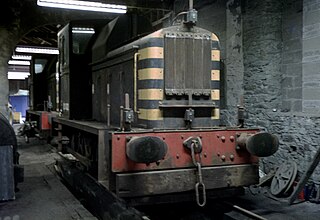
The British Rail Class 01 diesel locomotive is a short wheelbase 0-4-0 diesel-mechanical design intended for use in areas with tight curves and limited clearance.

The British Rail Class 02 are a class of twenty 0-4-0 diesel-hydraulic shunting locomotives built by the Yorkshire Engine Company in 1960 and 1961 (D2860-D2869) for service in areas of restricted loading gauge and curvature such as docks. They had the door to the cab at the rear, with a railed veranda behind the cab; this feature was very unusual on British Rail locomotives, although it was used on many Yorkshire Engine Co. designs and is quite normal in North American practice.

The British Rail Class 03 locomotive was, together with the similar Class 04, one of British Railways' most successful 0-6-0 diesel-mechanical shunters. 230 were built at Doncaster and Swindon works between 1957 and 1962, and were numbered D2000-D2199 and D2370-D2399. D2370 and D2371 were used as departmental locomotives and originally numbered 91 and 92 respectively.

The British Rail Class 05 is a class of 0-6-0 diesel-mechanical shunters built by Hunslet Engine Company from 1955 to 1961. They were used on the Eastern and Scottish Regions of British Railways. The first two batches were delivered as 11136-11143 and 11161-11176. Subsequent locomotives were delivered, new, as D2574-D2618.

The British Rail Class 06 is a class of 0-4-0 diesel-mechanical shunters built by Andrew Barclay Sons and Company from 1958 to 1960 for use on the Scottish Region of British Railways. They were originally numbered D2410–D2444 and later given the TOPS numbers 06001–06010.

The British Rail Class 07 diesel locomotive is an off-centre cab 0-6-0 diesel-electric shunter type built by Ruston & Hornsby in 1962 for the Southern Region of British Railways. The 14 members of the class were primarily used at Southampton Docks and later also at Eastleigh Works.
Brush Traction was a manufacturer and maintainer of railway locomotives in Loughborough, England whose operations have now been merged into the Wabtec company's Doncaster UK operations.
Peak Rail is a preserved railway in Derbyshire, England, which operates a steam and heritage diesel service for tourists and visitors to both the Peak District and the Derbyshire Dales.

The Yorkshire Engine Company Janus is a line of 0-6-0 wheel arrangement, diesel-electric locomotives that weighed 48 long tons and had a maximum speed of 23 mph (37 km/h). The two Rolls-Royce C6SFL diesel engines gave a total power output of 400 hp (300 kW). Each engine had its cooling system at the outer end, and its generator at the inner end. There were two traction motors, each being powered by one generator, thus simplifying the electrical system.

The North British Locomotive Company was created in 1903 through the merger of three Glasgow locomotive manufacturing companies; Sharp, Stewart and Company, Neilson, Reid and Company and Dübs and Company, creating the largest locomotive manufacturing company in Europe and the British Empire.
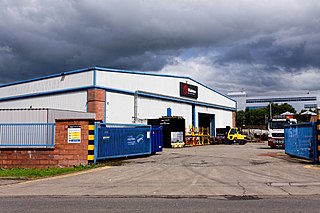
Andrew Barclay Sons & Co., currently operating as Brodie Engineering, is a railway engineering company, specializing in the heavy maintenance, refurbishment and overhauls for both passenger and freight rolling stock. Based around its works at Kilmarnock, it is the only active rail engineering business in Scotland.
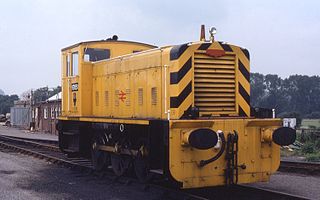
The British Rail Class 97/6 0-6-0 diesel shunting locomotives were purpose-built for departmental duties by Ruston & Hornsby at Lincoln in 1953 (97650) or 1959 (97651-654). There are minor technical differences between 97650 and the 1959 batch.

Hudswell, Clarke and Company Limited was an engineering and locomotive building company in Jack Lane, Hunslet, Leeds, West Yorkshire, England.

British Rail Class D1/3 was a locomotive class commissioned by British Rail in England. It was a diesel powered locomotive in the pre-TOPS period built by Ruston & Hornsby at their Iron Works in Lincoln. In appearance, it was similar to British Rail Class 97/6, but with an 0-4-0 wheel arrangement.

British Rail Class D2/12 was a class of ten locomotives commissioned by British Railways in England. They were diesel powered locomotives in the pre-TOPS period built by Hudswell Clarke with a Gardner engine. The mechanical transmission, using a scoop control fluid coupling and four-speed Power-flow SSS (synchro-self-shifting) gearbox, was a Hudswell Clarke speciality.
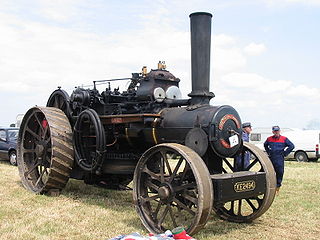
John Fowler & Co Engineers of Leathley Road, Hunslet, Leeds, West Yorkshire, England produced traction engines and ploughing implements and equipment, as well as railway equipment. Fowler also produced the Track Marshall tractor which was a tracked version of the Field Marshall. British Railways Engineering Department locomotives ED1 to ED7 were built by Fowler
The NZR DS class locomotive is a type of 16 diesel shunting locomotives built by the Vulcan Foundry and supplied by the Drewry Car Co from 1949–1955, for New Zealand Railways (NZR).

Locomotive Services Limited is a train operating company in Great Britain. The company operates rail tours using heritage steam, diesel and electric locomotives with support from associated companies and trusts.
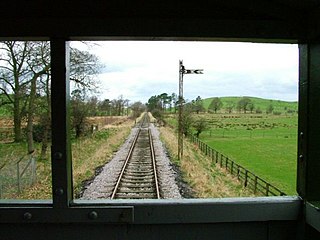
The Eden Valley Railway (EVR) is a standard gauge heritage railway in Cumbria, England. It runs over a 2.2 miles (3.5 km) section of the original Eden Valley Railway in a north-westerly direction from the line's base at Warcop station. The line is run by the Eden Valley Railway Trust, formerly the Eden Valley Railway Society.